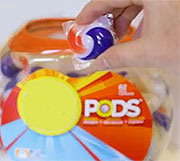
WEDNESDAY, Sept. 5 (HealthDay News) — Colorful and tempting, those single-wash packets of laundry detergent can be poisonous for toddlers who mistake them for candy, researchers warn.
Doctors at a children’s hospital in Great Britain reported seeing five such cases of detergent poisoning among children under age 2 over the past 18 months. Each of the children suffered serious chemical burns to the esophagus.
Experts in the United States say the products pose a similar threat to American children.
Several of the children in the British report had airway swelling bad enough that they needed a breathing tube (intubation), and several were admitted to the intensive care unit and one needed additional surgery to remove extensive scar tissue, according to Dr. Lyndsay Fraser, an ear, nose and throat doctor at the Royal Hospital for Sick Children in Glasgow.
“We’ve had an increasing number of cases over the last 18 months in which children have bitten into and swallowed liquid detergent,” Fraser said. “The color and texture is very, very appealing to children.”
The chemicals in laundry packets are highly alkaline, which can quickly damage soft tissues, Fraser explained.
The problem appears to be growing. In Great Britain, the National Poisoning Information Service received 647 telephone inquiries about laundry detergent poisoning; while the topic was searched on TOXBASE, a toxicology database for health professionals, nearly 4,000 times. Those figures make laundry detergent “the most common household product to be accidentally ingested,” according to the doctors.
In the United States, nearly 2,200 children age 5 and under either swallowed or got the detergent from laundry packets into their eyes between Jan. 1 and July 31, according to the American Association of Poison Control Centers (AAPCC).
The British report is published in the Sept. 5 issue of the Archives of Disease in Childhood.
Typically, swallowing laundry detergent causes mild stomach upset or even no symptoms. But the new laundry packets seem to be more potent, according to experts.
Children who’ve swallowed the liquid in the pods may vomit, wheeze or gasp for air. Some children have needed to be put onto a ventilator, according to the AAPCC.
The single-wash packets are designed to dissolve quickly in the washing machine, said Dr. Wendy Sue Swanson, a pediatrician with The Everett Clinic and Seattle Children’s Hospital, in Washington.
“Kids are curious, and they explore things with their mouth,” Swanson said. “Because the outer casing of the packets dissolves easily, once a toddler or young child chews on it, it can easily rupture and deliver the very concentrated laundry detergent into the child’s mouth.”
The packaging itself, because it’s designed to look appealing, draws small children, who may mistake it for a teething toy, said Dr. Tamara Kuittinen, director of medical education in the department of emergency medicine at Lenox Hill Hospital in New York City.
“It’s a painful reminder to parents that what’s attractive can also be dangerous,” Kuittinen said. “These things are meant to be attractive to catch our eyes as consumers. It also attracts kids eyes. The colors are beautiful. It looks yummy. Kids can suck on it, and the detergent leaks out.”
To protect children, parents should keep laundry detergents out of reach, preferably in locked cabinets, and not under the sink or anyplace else accessible to a toddler, Swanson said.
“You need to very extremely cautious about where they’re stored and how you use them,” Swanson said. “You should consider them just as potentially dangerous as a medication or another toxic household cleaner. Children should not be assisting putting them in the wash.”
Manufacturers should also redesign packaging with enhanced child safety caps, either voluntarily or with the help of a government mandate, Fraser said.
More information
If you think a child has been exposed to a laundry detergent packet, call your local poison center at 1-800-222-1222 immediately. The American Association of Poison Control Centers has more on laundry detergent packets.

